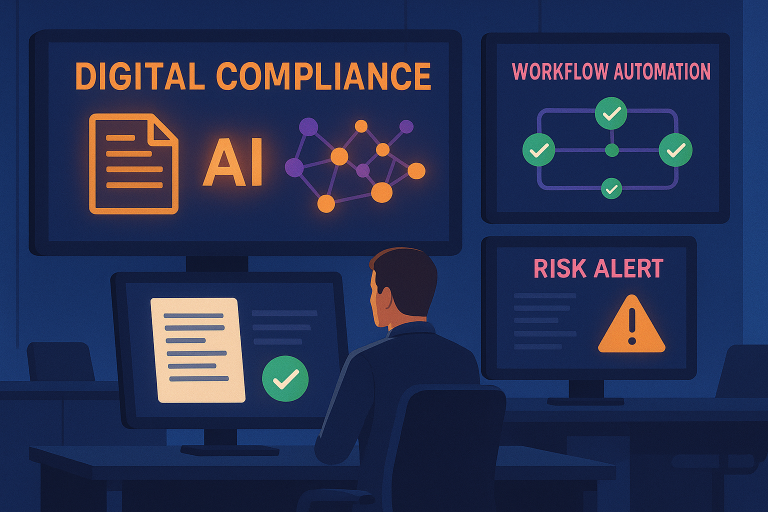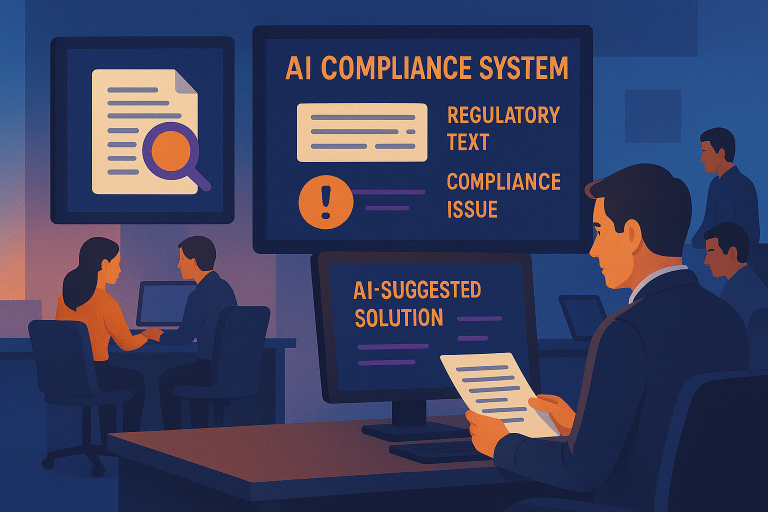Ensuring Regulatory Conformity with AI Workflow Compliance
In today’s complex regulatory environment, businesses face an ever-growing challenge of maintaining compliance across multiple jurisdictions and frameworks. Manual processes are increasingly inadequate, error-prone, and resource-intensive. This is where AI workflow compliance systems are revolutionizing how organizations approach regulatory conformity – transforming tedious manual tasks into streamlined, intelligent workflows that continuously adapt to changing requirements.

From financial services to healthcare, manufacturing to technology, organizations across industries are discovering that AI-powered compliance isn’t just about avoiding penalties—it’s about creating more efficient operations, reducing risks, and building trust with customers and regulators alike. Let’s explore how these advanced systems are reshaping regulatory compliance and how your organization can benefit from this transformation.
Understanding AI Workflow Compliance
AI workflow compliance represents the intersection of artificial intelligence, process automation, and regulatory requirements. At its core, it’s about leveraging machine intelligence to ensure business processes consistently adhere to applicable laws, regulations, and industry standards with minimal human intervention.
The Evolution of Compliance Automation
The journey to today’s sophisticated AI compliance systems has been marked by several key developments:
- Historical compliance challenges: Traditionally, compliance relied on armies of legal experts manually reviewing processes, documents, and transactions—an approach that was slow, expensive, and error-prone.
- Transition from manual to automated compliance: The first wave of digitization brought basic rule-based systems that could flag obvious violations but lacked intelligence and adaptability.
- Rise of AI in regulatory technology: The emergence of advanced AI capabilities has transformed compliance from a reactive cost center into a proactive business enabler.
This evolution hasn’t simply made compliance faster—it has fundamentally changed how organizations approach regulatory requirements, moving from point-in-time assessments to continuous compliance monitoring and assurance.
Core Components of AI Compliance Workflows
Modern AI compliance systems typically incorporate several integrated components:
| Component | Function | Impact |
|---|---|---|
| Rule Engines | Translate regulatory requirements into executable logic | Ensures consistent policy application across all workflows |
| Document Processing | Extracts, analyzes, and validates information from documents | Reduces manual review time by 70-90% |
| Continuous Monitoring | Provides real-time observation of processes for compliance violations | Catches issues before they become regulatory incidents |
| Automated Reporting | Generates compliance documentation and regulatory filings | Ensures timely, accurate submissions to authorities |
These components work together to create an intelligent compliance ecosystem that can adapt to changing regulations while maintaining operational efficiency.
Key Benefits of AI-Driven Compliance
The implementation of AI workflow compliance solutions delivers multiple advantages that extend far beyond simply avoiding penalties. These systems transform compliance from a burden into a competitive advantage.
Risk Reduction and Error Prevention
AI excels at maintaining consistency and accuracy in ways that human-driven processes cannot match:
- Minimizing human error: AI systems eliminate the inconsistencies and oversights that naturally occur with manual processing, particularly for repetitive tasks.
- Consistent application of policies: Rules are applied uniformly across all transactions, processes, and departments, eliminating interpretation variations.
- Early detection of potential violations: Predictive analytics can identify patterns that indicate emerging compliance risks before they manifest as violations.
- Pattern recognition advantages: AI can detect subtle connections and anomalies across vast datasets that would be impossible for human reviewers to identify.
For regulated industries, this risk reduction represents not just cost savings but also protection of brand reputation and customer trust.
Operational Efficiency and Cost Savings
The economic case for AI compliance automation is compelling:
“Organizations implementing AI-driven compliance workflows report an average 30% reduction in compliance-related costs while simultaneously improving their regulatory risk profile.”
These savings come from multiple sources:
- Reduced manual processing time: Tasks that once took days or weeks can be completed in hours or even minutes.
- Resource allocation optimization: Compliance personnel can focus on strategic issues rather than routine document processing.
- Scalability during regulatory changes: Systems can rapidly adjust to new requirements without proportional increases in staff or costs.
- Lower total cost of ownership: While implementation requires investment, the long-term TCO is significantly lower than maintaining traditional compliance approaches.
For many organizations, the efficiency gains alone justify the transition to AI-powered compliance workflows.

Implementing AI Compliance Across Industries
While regulatory compliance is universal, each industry faces unique requirements and challenges. AI workflow systems can be tailored to address these specific needs.
Financial Services and Banking Compliance
The financial sector remains one of the most heavily regulated industries, making it a natural fit for AI compliance solutions:
- AML and KYC automation: AI systems can verify customer identities, screen against watchlists, and detect suspicious transaction patterns with greater accuracy than manual processes.
- Transaction monitoring: Real-time analysis of transactions against complex rule sets ensures continuous compliance with trading regulations.
- GDPR and data protection compliance: Automated data mapping, consent management, and privacy impact assessments streamline data protection compliance.
- Financial reporting requirements: AI-assisted preparation and validation of regulatory filings reduces errors and ensures timely submissions.
Financial institutions implementing AI compliance systems report not only reduced regulatory risk but also improved customer onboarding experiences and faster transaction processing.
Healthcare and Pharmaceutical Regulations
The healthcare industry faces stringent regulations designed to protect patient safety and privacy:
- HIPAA compliance automation: AI systems can continuously monitor access to protected health information, automatically detecting and reporting potential violations.
- Clinical trial documentation: Automated processing ensures all required documentation is complete, accurate, and submitted according to protocols.
- Drug safety monitoring: AI systems can detect adverse event signals across disparate data sources, ensuring timely reporting to authorities.
- Patient data protection workflows: Automated controls ensure patient data is accessed, stored, and transferred in compliance with applicable regulations.
For healthcare organizations, AI compliance workflows don’t just reduce regulatory risk—they help ensure patient safety and build trust in increasingly data-driven healthcare delivery.
Manufacturing and Supply Chain Compliance
Manufacturing faces complex regulatory requirements across product safety, environmental impact, and supply chain transparency:
- Quality assurance automation: AI systems can monitor production parameters in real-time, ensuring adherence to quality standards and regulatory requirements.
- Environmental regulation adherence: Automated monitoring and reporting of emissions, waste disposal, and resource usage ensure continuous environmental compliance.
- Supply chain transparency: AI-powered tracking systems ensure compliance with sourcing requirements, conflict mineral regulations, and modern slavery laws.
- Product safety compliance: Automated testing protocols and documentation ensure products meet all applicable safety standards before release.
Manufacturers implementing AI compliance workflows report fewer product recalls, smoother regulatory approvals, and improved ability to enter new markets with different regulatory requirements.
Technical Foundations of AI Compliance Systems
The effectiveness of AI compliance workflows depends on sophisticated technologies working in concert to interpret, apply, and monitor regulatory requirements.
Natural Language Processing for Regulatory Interpretation
Understanding complex regulatory language is a fundamental challenge that NLP technology addresses:
- Automated regulatory text analysis: NLP algorithms can parse dense regulatory documents to extract specific requirements and obligations.
- Semantic understanding of requirements: Advanced language models capture the meaning and intent of regulations, not just keywords.
- Translation of regulations into executable rules: NLP systems can transform regulatory text into structured rules that can be implemented in workflow systems.
- Handling regulatory ambiguity: AI systems can identify areas of potential interpretation variance, flagging them for human expert review.
This capability allows organizations to rapidly adapt to new or changing regulations without extensive manual analysis and interpretation.
Machine Learning for Adaptive Compliance
Machine learning enables compliance systems to continuously improve their effectiveness:
- Compliance pattern recognition: ML algorithms identify patterns in compliant and non-compliant processes, improving detection capabilities over time.
- Anomaly detection in workflows: Advanced clustering algorithms can identify unusual processes or transactions that may indicate compliance risks.
- Predictive compliance monitoring: ML models can forecast potential compliance issues based on historical patterns and current trends.
- Learning from audit outcomes: Systems improve by incorporating feedback from regulatory examinations and internal audits.
This adaptive capability ensures that compliance systems become more effective over time, continuously improving their ability to identify and mitigate regulatory risks.
Challenges and Considerations
Despite their benefits, implementing AI workflow compliance solutions comes with important challenges that organizations must address.
Ensuring AI Explainability and Transparency
Regulatory authorities increasingly require that compliance decisions can be explained and justified:
- Explainable AI requirements: Organizations must ensure their AI systems can provide clear rationales for compliance decisions.
- Audit trails for compliance decisions: Comprehensive logging of AI decision factors is essential for regulatory examinations.
- Human oversight integration: Effective systems maintain appropriate human supervision of AI-driven compliance processes.
- Regulator acceptance of AI compliance: Organizations must ensure their automated approaches meet regulator expectations for diligence and thoroughness.
These challenges highlight the importance of selecting AI compliance systems designed with transparency and auditability as core features.
Integration with Legacy Systems
For most organizations, AI compliance must work alongside existing systems:
- Data migration considerations: Historical compliance data often needs to be transferred to new systems while maintaining its integrity and auditability.
- API connectivity requirements: Effective compliance systems need to connect with multiple data sources across the organization.
- Hybrid compliance approaches: Practical implementation often requires a mix of AI-driven and traditional compliance processes during transition periods.
- Phased implementation strategies: Successful adoption typically follows a careful sequence of deployment across different regulatory domains.
Careful planning around these integration challenges is essential for successful implementation of AI compliance workflows.
Future of AI Workflow Compliance
The compliance landscape continues to evolve rapidly, with several emerging trends shaping the future of regulatory technology.
Regulatory Technology (RegTech) Innovation
The RegTech ecosystem is developing new approaches to compliance challenges:
- Collaborative compliance platforms: Shared systems where multiple organizations can jointly address common regulatory requirements.
- Cross-border regulatory harmonization: AI systems that can reconcile requirements across multiple jurisdictions for global operations.
- Real-time compliance monitoring: Continuous assurance systems that provide instant visibility into compliance status.
- Compliance as a service models: Specialized providers offering comprehensive AI compliance capabilities through cloud-based platforms.
These innovations are making sophisticated compliance capabilities accessible to organizations of all sizes.
Preparing for the Next Generation of Regulations
Forward-looking organizations are already preparing for emerging regulatory domains:
- AI-specific regulatory requirements: As AI itself becomes regulated, compliance systems will need to monitor adherence to AI ethics and safety requirements.
- Ethical AI compliance: Organizations will need to demonstrate their AI systems operate within ethical boundaries and avoid discriminatory outcomes.
- Climate and sustainability regulations: AI compliance systems will increasingly monitor adherence to environmental standards and emissions requirements.
- Cross-industry compliance standardization: Emerging frameworks aim to create more consistent compliance approaches across previously separate regulatory domains.
Organizations that implement flexible AI compliance systems today will be better positioned to adapt to these emerging requirements.
Conclusion: The Strategic Imperative of AI Workflow Compliance
AI workflow compliance has evolved from an experimental technology to a strategic necessity for organizations in regulated industries. By automating complex regulatory processes, these systems simultaneously reduce risks, lower costs, and improve operational efficiency.
The most successful implementations focus not just on technology deployment but on reimagining compliance as an integrated business function that provides competitive advantages through greater agility and reduced regulatory friction.
As regulatory environments continue to grow in complexity, AI workflow compliance will increasingly separate industry leaders from those struggling to keep pace with their compliance obligations. For forward-thinking organizations, the question is no longer whether to implement these systems, but how quickly they can be deployed to capture their transformative benefits.




